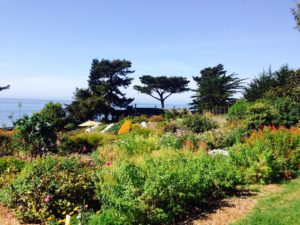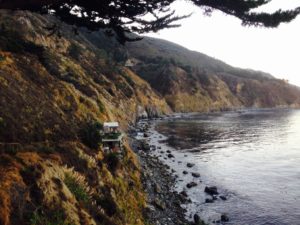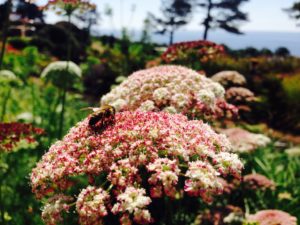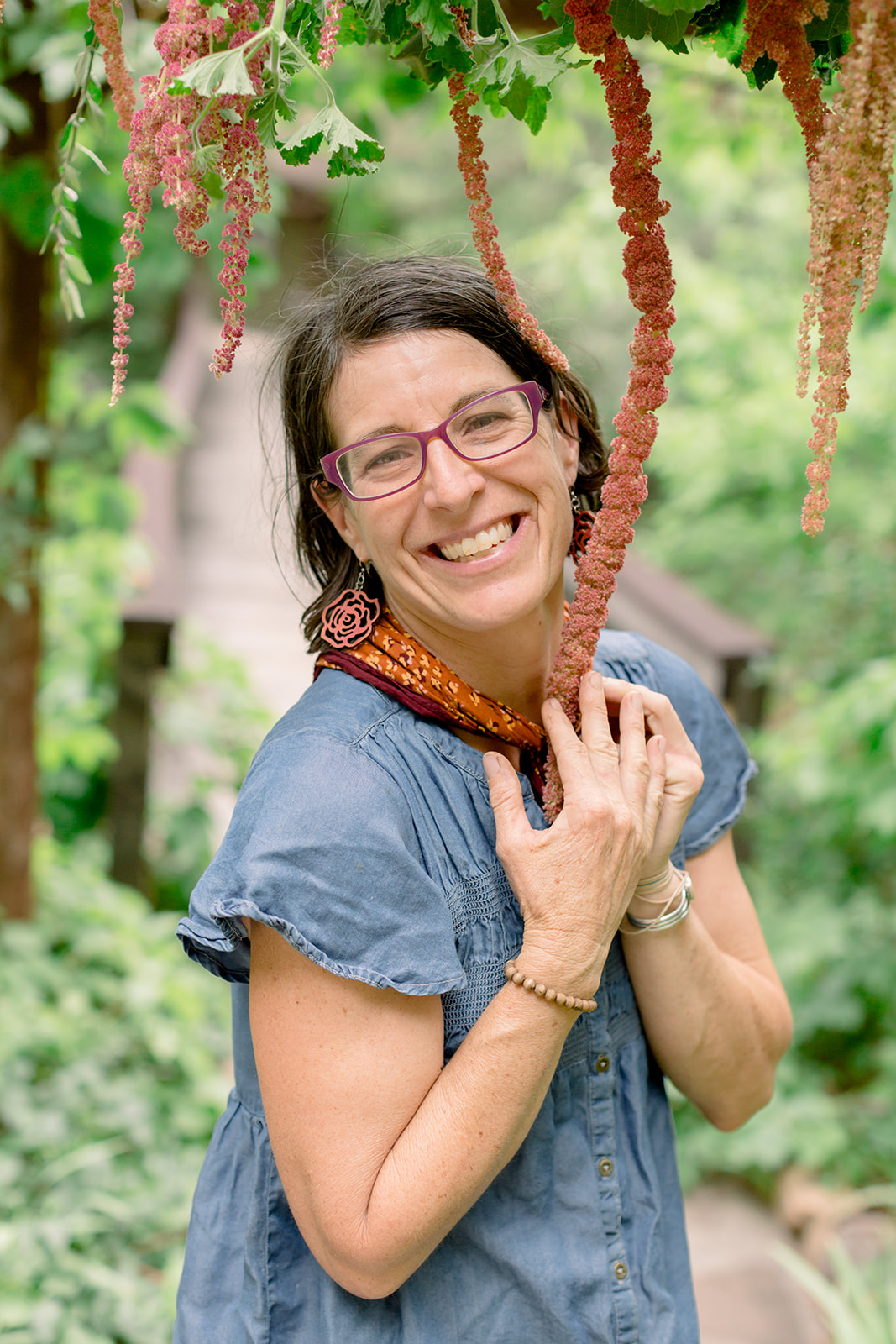 The darkening days of December are a struggle for me. I should be sleeping but the process of turning inward keeps me up all night by the fire, reading and dreaming and scheming. This is the time of year to plan the next farm season. For a novice, landless, itinerant farmer this means a great deal of uncertainty and unrest.
The darkening days of December are a struggle for me. I should be sleeping but the process of turning inward keeps me up all night by the fire, reading and dreaming and scheming. This is the time of year to plan the next farm season. For a novice, landless, itinerant farmer this means a great deal of uncertainty and unrest.
On a recent long night, I remembered a trip down the winding Big Sur coast road at sunset. It was the last week of my apprenticeship at the UCSC Farm and Garden, and a few of us decided to volunteer on the farm at the Esalen Institute in exchange for meals and hot soaks. We had to camp somewhere nearby to arrive for a 7 a.m. start. The only reservations available were at Andrew Molera Park, where we had to walk a quarter mile to the campsite through a forest of riparian trees in full darkness.
Giant hands of sycamore leaves silhouetted the bright sky glittering with stars. I had not seen the Milky Way in some time, as the coastal fog moves in most evenings. The dazzling brushstroke was invigorating and grounding, like setting eyes on an old friend. We pitched camp under a towering oak; then, intrigued by the steady pounding of ocean surf somewhere in the distance, we set off in search of it. We reached an estuary where the river joined the sea and gazed at a mirror of starlight reflected in the water. I brought out my ukulele and we sang songs about water and stars. A shooting star with a sparkling green tail exploded across the atmosphere then quickly dissolved. On our way back, my headlamp caught the iridescent pink eyes of a moth dipping its proboscis into the small white flowers of the brickellia bush, a native plant I recognized from the hedgerow on our farm that attracted many beneficial insects.
We woke before dawn, packed up camp and walked back out of the woods still under a veil of darkness. We lamented not being there to see it in the daylight, but then I recalled everything I had witnessed despite the darkness, and all that I had reserved for my imagination.
 We arrived at Esalen as the sun inched from beneath the ocean. This is a retreat for seekers and thinkers, perched on the expansive Big Sur coastline and far away your life, which feels insignificant in comparison to the surroundings. Narrow paths wind through tended gardens, bridge steep waterfalls and lead into the towering redwood forests of the Ventana Wilderness.
We arrived at Esalen as the sun inched from beneath the ocean. This is a retreat for seekers and thinkers, perched on the expansive Big Sur coastline and far away your life, which feels insignificant in comparison to the surroundings. Narrow paths wind through tended gardens, bridge steep waterfalls and lead into the towering redwood forests of the Ventana Wilderness.
Our bellies full of coffee and nourishing farm-to-cafeteria food, we gathered in a circle under a shade canopy with the other volunteers. We took turns introducing ourselves with a quick psychic check-in, which is an Esalen tradition. Transition emerged as a universal theme, as it was also with Mother Earth. The plants were slowing down and fields were being seeded with cover crops. I, too, was harnessed to the season, summoning my energy to trim weed up North before winter so I could return home with some money in my pocket, but that is another story.
I harvested and processed kale, salad mix and herbs for the kitchen, at moments pausing to observe a bee pollinating Queen Anne’s lace flowers and the ocean views just beyond. After work I sat on an expanse of lawn in the afternoon sun, looking out at the sea trying to capture this experience in my journal. I had grown fond of this horizon of salty water churning with the planetary pull. Its largeness was reassuring.
I recalled filling pages from this very spot five years earlier with my best friend Karla on a Sun Magazine writing retreat. We were each granted 15 minutes alone with Sy Syfranski, editor, publisher and father of the Sun. “Ask or tell me anything,” he dared, “I will listen.”
I found Sy sitting on a pile of pillows in one of the meditation rooms and suddenly wondered what the heck am I doing here? I have nothing to say! But his unassuming, Buddha-like manner immediately put me at ease. His round glasses and sparse, wispy, gray curls gave him the look of a wise, self-effacing owl. “I don’t know where to begin,” I said. He asked me why I came to the workshop. Through our short conversation, I took a break from doubting and gained some clarity. I realized that I came to hear my own words and listen to others speak theirs (the best and worst part of writing workshops—sharing). I wanted to remember why I write, why it feels necessary. I wanted to remember that the process usually leads me to a deeper understanding and with it I wanted to somehow change the world.
 I wanted to know how Sy faces the blank page every month for his column. Was there a secret code he could share, writer to writer? How does he quiet the naysayers in his mind or overcome procrastination? My column deadline looms constantly, and every six weeks I think I’ll do better, I’ll start earlier. Then suddenly it is the week, the day then the night before and I haven’t. With each deadline my own small life flickers back from the computer screen and I doubt that I can say anything new, original, funny, intelligent or important. This is the necessary darkness of writing and I enter it willingly. Owl eyes blinking, Sy expressed that it is always hard, but finding a rhythm to your writing practice will make it easier.
I wanted to know how Sy faces the blank page every month for his column. Was there a secret code he could share, writer to writer? How does he quiet the naysayers in his mind or overcome procrastination? My column deadline looms constantly, and every six weeks I think I’ll do better, I’ll start earlier. Then suddenly it is the week, the day then the night before and I haven’t. With each deadline my own small life flickers back from the computer screen and I doubt that I can say anything new, original, funny, intelligent or important. This is the necessary darkness of writing and I enter it willingly. Owl eyes blinking, Sy expressed that it is always hard, but finding a rhythm to your writing practice will make it easier.
The rhythm of my life changed vastly since that time. I’m no longer the same person I was five years ago. This current chapter I am writing wasn’t even a twinkle in my eye. What has not changed is my obligation to writing, my curiosity for the darkness, and all that I find there.

